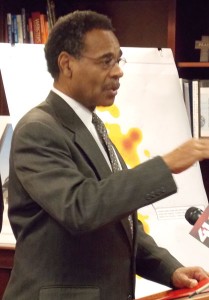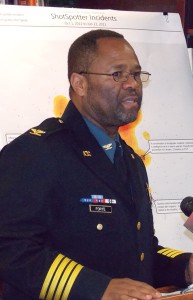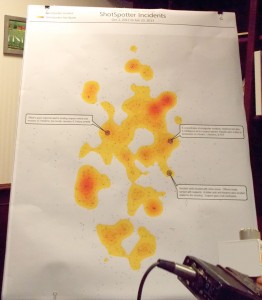
By JOSHUA PHILLIPS
Northeast News
July 10, 2013
The Kansas City Police Department (KCPD) is able to catch criminals quicker and bring the community together with the help of a U.S. Congressman, KCPD Chief Darryl Forté said.
Since October 2012, KCPD has used the ShotSpotter technology to detect when and where a firearm goes off in order to make arrests more quickly. Their ultimate goal is to reduce crime in Kansas City, Mo., with this new technology.
Congressman Emanuel Cleaver, II, spoke to Forté and Kansas City Area Transportation Authority (KCATA) General Manager Mark Huffer in 2012 about bringing ShotSpotter technology to Kansas City after Cleaver spoke with Washington, D.C., Metropolitan Police Department Chief of Police Cathy L. Lanier about their ShotSpotter technology.
“It would be wrong to assume that ShotSpotter is the solution,” Cleaver said. “It is the strategy that is implemented to demonstrate to the hoodlums there is a new system in town that is going to jeopardize your activities. We think that when the public becomes actively involved in the neighborhood that it automatically becomes a better neighborhood.”
Cleaver said the technology can distinguish between the sound of fireworks, a car backfiring and a gunshot. ShotSpotter technology can detect a fired gunshot within 30 to 60 seconds and determine the location it was fired from, as well as detect which direction and how fast the bullet is traveling, how many shots fired and when the firearm was fired. KCPD then responds to the scene to assess the situation, and later warrants for arrests are filed, depending on the exact crime committed.
Since ShotSpotter was implemented in Kansas City, there have been six felony arrests, three incidents of felons in possession, six misdemeanor arrests, 13 firearms recovered, six incidents where narcotics were recovered, 342 shell casings were recovered and 96 live rounds were recovered. Forté did not disclose the locations, stating he did not want those committing crimes to know where the ShotSpotter technology is located.
Forté mentioned three incidents when the ShotSpotter helped KCPD make arrests. In the first incident, two felony arrests were made and two firearms and narcotics were recovered at one location. In the second incident KCPD had a search warrant for the residence and two firearms and PCP were recovered. The third incident mentioned had a gunshot victim at the scene and once KCPD arrested the shooting suspect, the suspect confessed to the crime.
“The numbers and incidents are important, but to me the piece that is most important is the relationship we are building with the community,” Forté said. “A lot of times in the past we weren’t called. Now, five to 10 years later, where there have been shots in an area, we show up and people will come out of their homes to know what is going on.”
Huffer was contacted by Cleaver last fall about the idea to use ShotSpotter in Kansas City.
“We were able to use some of the money from the Troost Max Project from 28th to 39th streets on Troost where our heaviest ridership is in,” Huffer said. “It was Cleaver’s idea, Chief Forté jumped onto the opportunity and we worked with MoDOT and the Federal Transit Administration in terms of funding and getting that money reprogrammed from that project to use for this technology.”
Cleaver said he hopes to go back to Washington, D.C., and ask for more funding for the ShotSpotter technology. KCPD already has $720,000 budgeted to use for the technology.
Forté said engagement from the community increases when the community sees how KCPD is being responsive and talking with the community.




















